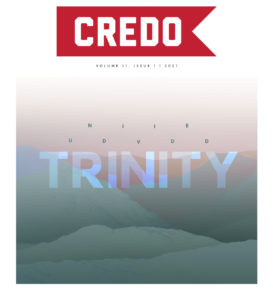
An Appropriate Pact
T he new issue of Credo Magazine focuses on the trinity. The following is an excerpt from one of the issue’s featured articles by Jake Rainwater. Rainwater is the Assistant Registrar and a Ph. D student in systematic theology at Midwestern Baptist Theological Seminary. His research interests include the doctrine of sanctification, soteriology, and theological methodology.
he new issue of Credo Magazine focuses on the trinity. The following is an excerpt from one of the issue’s featured articles by Jake Rainwater. Rainwater is the Assistant Registrar and a Ph. D student in systematic theology at Midwestern Baptist Theological Seminary. His research interests include the doctrine of sanctification, soteriology, and theological methodology.
Virtually any study of Reformed, covenant theology involves studying the covenant of redemption. It stands as an important link between the triune work of salvation and the unity of the Godhead, both in essence and in will.
Largely a product of post-Reformation exegesis and doctrinal synthesis, the covenant of redemption, or pactum salutis, is the eternal intra-Trinitarian pact made by the Father, Son, and Holy Spirit to accomplish and apply salvation to the elect. It provides the eternal foundation of our salvation, and the covenantal context in which salvation occurs.
However, the pactum is not without its critics and mishandlers. One of the most potent critiques comes from those who argue that the pactum is not sufficiently Trinitarian. By not considering the doctrine of divine simplicity, some argue that the covenant of redemption necessitates introducing multiple wills into the Godhead. Unfortunately, these charges are not entirely unmerited, as some have utilized the pactum to ground ontological authority and submission dynamics in the inner life of the Trinity.
While critics and misuse threaten the covenant of redemption’s demise, I believe that the covenant of redemption is vital in understanding the unity of the Trinity’s mission. Additionally, and perhaps counterintuitively, rather than standing in opposition to the pactum, the doctrine of divine simplicity provides important context for the pactum’s construction by way of the doctrine of divine appropriation.
The Covenant of Redemption: Doctrine, Reception, and Biblical Basis
From beginning to end, salvation is Trintiarian. Click To Tweet From beginning to end, salvation is Trintiarian. Writing in the 180s, Irenaus of Lyons described how the persons of the Trinity work together in salvation as “the Father planning everything well and giving his commands, the Son carrying these into execution and performing the work of creating, and the Spirit nourishing and increasing [what is made].” From planning, to accomplishing, to applying, the persons of the Godhead work inseparably according to the singular, divine will, to bring about redemption.
At its core, the pactum salutis is an attempt to understand those passages of Scripture which describe the persons of the Trinity planning and accomplishing salvation in eternity, giving us insight into the very heart of the Trinity’s nature and mission. The covenant of redemption is located in eternity, that is, before any other external work of the Trinity, and it entails the Father’s appointment of the Son to accomplish redemption through his incarnation, life, death, resurrection, and ascension, as well as the Spirit’s role to anoint and equip the Son for his mission as surety and to apply his finished work to the elect. Thus, Scott Swain, utilizing Hebrews 2:10, says the pactum concerns the divinely ordained, messianic means whereby the Father, “for whom and by whom all things exist,” seeks to manifest his glory by “bringing many sons to glory.”
The seeds of the pactum can be found as early as Jerome’s (ca. 347-420) commentary on Zechariah 6:13, which Herman Wistius appealed to in defending the doctrine’s antiquity. The skeletal structure of the pactum can also be found in the works of Caspar Olevianus (1536-87), Martin Luther (1483-1546), and Jacob Arminius (1560-1609). However, it is not until the post-Reformation in the thought of theologians such as David Dickson, Johann Cloppenburg, Peter Bulkeley, Johannes Coceius, and Herman Witsius that that the doctrine came to full blossom.
Often, the covenant of redemption is charged with “novelty.” How could such a relatively late product of reformed thought hold such a place of prominence in the tradition? What these charges fail to account for is the surge in exegetical endeavors that the Reformation created with its emphasis on the original biblical languages. By the 16th and 17th centuries, theologians began to move away from drawing their theology from the Latin Vulgate, and began to utilize Greek and Hebrew in their exegetical and theological endeavors.
The pactum comes together, not by way of isolated prooftexts, but by weaving together several passages and themes from across both Testaments. Click To Tweet For example, this push to the original languages drove Theodore Beza (1519-1605) to reject the Latin translation of Luke 22:29 – “I appoint (dispono) to you a kingdom” – and translate the Greek word διατίθεμαι as “I covenant to you” instead.
Thus, according to Beza, Jesus covenants a kingdom to his disciples just as it was covenanted to him. Rediscovered covenantal dimensions in passages like Luke 22:29 led to the formation of the covenant of redemption, not by way of unwarranted theologizing, but by way of careful exegesis.
However, Luke 22:29 is not the only passage that the framers of the covenant of redemption use to formulate their doctrine. Along with Zechariah 6:13, Psalm 2:7 and 110:1 serve as Old Testament texts which position the reign of Christ over creation in distinctly covenantal terms. These passages seem to describe an eschatological vision of the Son, the priest-king who rules at the right hand of Yahweh. All three passages share a covenantal context, evident in specific words and phrases such as “council of peace” (Zech 6:13), “decree,” and “today” (Ps 2:7), or Yahweh’s oath to make the Son’s enemies a footstool (Ps 110:1).
In the New Testament, both Ephesians 1 and 2 Timothy 1:9-10 are passages which, along with Luke 22, contribute to the covenant of redemption’s formulation. In both passages, Paul locates the origins of salvation in God’s election “in Christ.” Temporally, this election in Christ occurred “before the foundations of the earth,” and “before the ages began.”
These theologians who first articulated the covenant of redemption did so because they saw it as the natural theological conclusion to their exegesis. The pactum comes together, not by way of isolated prooftexts, but by weaving together several passages and themes from across both Testaments.
**Read the remainder of Jake Rainwater’s article in the latest issue of Credo Magazine.

